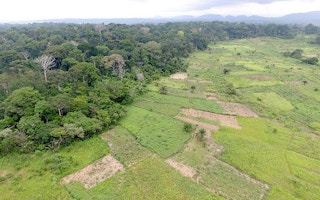Halting the pace at which we’re destroying the world’s forests for agriculture, forestry, mines, and other economic development projects is crucial to combating climate change.
Carbon finance, which involves creating monetary incentives for companies and countries to invest in programs to reduce carbon emissions, is one potential solution being employed today.
Though large-scale financial flows have yet to materialise, and it’s still unclear just how effective the strategy will prove to be for funding efforts to keep forests standing, many REDD+ projects and other conservation initiatives have been designed to take advantage of current or future revenues from carbon markets.
But a study published in the journal Environmental Research Letters earlier this month found that, while carbon finance can be effective in the right circumstances, it is not a one-size-fits-all solution.

A workshop in Tanzania to determine how land use might affect forests and carbon emissions. Photo © Ashwin Ravikumar, The Field Museum via Mongabay.com
Ashwin Ravikumar, an environmental social scientist at The Field Museum in Chicago and the study’s lead author, led a team that included researchers with the Department of Forest Services in Finland and the Center for International Forestry Research in Peru that looked at the potential of eight landscapes in four countries around the world to generate carbon revenues.
Ravikumar and team held workshops in Indonesia, Mexico, Peru, and Tanzania, where they talked with local farmers, politicians, NGOs, and businesses about how they saw economic activities affecting land use in their region in the coming decades.
The team then analysed the responses they’d collected through these “future scenario building exercises” using a tool called CarboScen that calculates the landscape carbon storage implications of different land use scenarios.
“
Conventional wisdom says that if you save a forest, you’ll make a big difference in carbon emissions, which would translate to a lot of money in the carbon market. But that’s not always what we saw.
Ashwin Ravikumar, environmental social scientist, The Field Museum
The results varied widely: Potential revenue from carbon storage or emissions reductions were significant in some landscapes, such as the peat forests of Kalimantan, Indonesia, but much less significant in other areas, like the low-carbon forests of Zanzibar and the interior of Tanzania.
In other words, the team found that carbon-based payments for conservation, whether they’re delivered through markets or other mechanisms, are appropriate in some places but not in others — which calls into question the practicality of many conservation programs that rely on expectations of future revenue from carbon finance, the researchers write in the study.
“We were shocked by how much income could be generated by carbon finance in some areas and how little it could bring in others,” Ravikumar said in a statement. “Conventional wisdom says that if you save a forest, you’ll make a big difference in carbon emissions, which would translate to a lot of money in the carbon market. But that’s not always what we saw.
In the forests of southern Mexico and the interior of Tanzania, for example, there wasn’t a huge difference in carbon emissions between aggressive conservation and high deforestation scenarios. On the flip side, we were blown away by how critical the peat forests in Indonesia [are] for reducing carbon emissions.”
One reason for the wide variability between projections of future carbon revenues for different landscapes is their carbon storage potential — the amount of carbon that can be stored in soil, trees, and other vegetation. There’s more carbon stored in the leafy trees of tropical Amazon rainforests than in a dry Canadian forest populated with pines, for instance.
Peat forests, where the soil contains an abundance of complex organic matter, are especially carbon-dense and thus often great candidates for carbon finance, meaning that countries with peat forests could stand to reap big carbon finance rewards for conserving them.
“If you incentivised carbon storage… conserving environments like that peat forest could earn 3.5 billion dollars over the course of thirty years,” Ravikumar said. “Meanwhile, the model shows that conserving a dry forest in Zanzibar would net only about 38 million over the same time frame — much less than the peat forest.”
Being able to accurately estimate the benefits of carbon finance is crucial, Ravikumar notes: “If you’re working with local people and telling them how preserving a forest could benefit them, you need to be able to give them realistic expectations. If you’re wrong, it undoes the legitimacy of the project and breaks down trust.”
Ravikumar would like to see the study used to inform future policy decisions regarding conservation and carbon finance. “My hope is that policy-makers and NGOs will think critically about how carbon finance will work in their area,” he said.
“In places that we want to conserve, we shouldn’t put all our eggs in the carbon finance basket when those eggs might not hatch. But there are cases when carbon finance could have an enormous conservation impact, and studies like this one can help us to determine what those cases are.”
Forests are one of the most important tools available to us for mitigating global climate change, and the methods used in this study can help determine what the viable solutions might be in different areas, Ravikumar added: “No one solution will work everywhere — we need to tailor solutions and funding streams to individual situations.”
This story was published with permission from Mongabay.com










